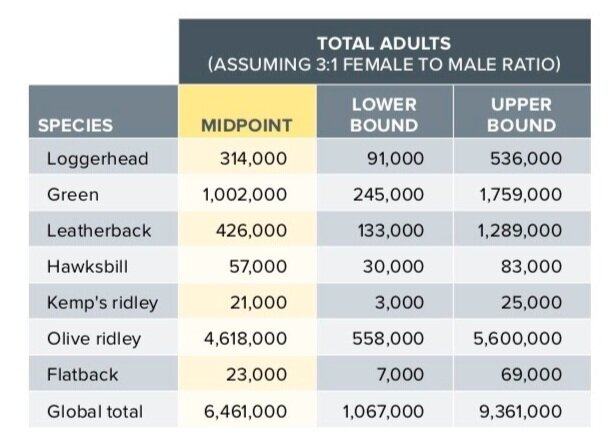How Many Sea Turtles Are There?
By BRYAN P. WALLACE
Sea turtles swim in all of the ice-free areas of the world’s oceans. Their generations span several decades, so populations comprise turtles of many sizes and ages. What’s more, we humans catch only fleeting glances of them in the ocean, seeing mostly the females that come ashore to nest, so typically we can count just egg-laying adult females and their offspring. With all this in mind, making defensible estimates of the total number of sea turtles in the ocean requires math, modeling, assumptions, and a lot of creativity. But let’s give it a try!
Others have tried estimating the number of turtles in the sea when trying to paint a picture of what marine resources looked like historically. For example, studies of historical harvesting and fishing records from 300 to 500 years ago estimated that between 33 million and 39 million, or even as many as 91 million, adult green turtles existed in the Caribbean before Columbus’s fleet, and those that followed it, took their toll. The historical abundance of sea turtles is the stuff of legends: there were so many green turtles in the Caribbean that the sounds of turtles breathing and the bonking of their carapaces against the ships’ wooden hulls were cues used by sailors to navigate around islands when visibility was poor.
Olive ridley arribada at Playa Escobilla, Oaxaca, Mexico. © Tui de Roy / Roving Tortoise Photos
For Europeans invading the Caribbean, sea turtles were free, they were relatively easy to catch, and they could be kept alive for weeks with minimal care, thus serving as a seemingly endless source of fresh meat and eggs. Europeans were unfamiliar with the region, and most islands did not readily provide agricultural resources to support new settlements, so it is no exaggeration to say that sea turtles fueled European invasion, exploitation, and colonization of the Americas. Think about that: one of the most consequential turning points in human history might not have happened if the sea wasn’t full of turtles.
Historical depletion by European exploitation is now a well-documented theme in the Caribbean and elsewhere, so we know that today’s populations of green turtles—and all other species—are far smaller than before Europeans got a taste for them. But how much have populations been depleted? And how many are there today? There is no robust estimate, and for the reasons raised above, generating an accurate number is probably impossible. However, a 2011 paper (Wallace et al. 2011) provided defensible estimates of nesting population abundance (in average annual ranges) for all sea turtle regional management units worldwide. If we sum up the minimum and maximum values of those estimated ranges, we can calculate rough estimates of the total number of nesting females. With assumptions about sex ratios, we can even estimate the number of adult males too. (I will leave estimates of juvenile turtles to braver folks than I.)
Female abundance estimates were derived from the midpoints and upper and lower bounds of ranges of average annual abundance in Wallace et al. (2011) Global conservation priorities for marine turtles, PLoS ONE 6(9): e24510. doi:10.1371/journal. pone.0024510. Average remigration intervals by species were used to estimate total numbers of adult females, and an assumed 3:1 sex ratio allowed for estimation of total numbers of adult males. These abundance estimates were generated for illustrative purposes only and should be interpreted accordingly.
The totals from this exercise show that, as of 2011, a maximum of 7.5 million adult females of all sea turtle species existed globally. Assuming a 3:1 ratio of females to males, fewer than 10 million adult sea turtles remained. For green turtles alone, there were perhaps 1.5 million females worldwide, and only 300,000 in the Caribbean. That’s quite a bit different than the historical estimates before European exploitation.
Despite the dramatic declines in turtle abundance since Europeans arrived, turtles have been hanging on. In some places, their numbers have increased in recent years. Over the past several centuries and even in recent decades, humans have done a great job of reducing sea turtle numbers through consumption and other activities. Now it’s up to today’s and tomorrow’s humans to do a great job at reversing those trends.
This article originally appeared in SWOT Report, vol. 15 (2020) as part of a feature exploring Frequently Asked Questions About Sea Turtles.
Click here to download the complete article as a PDF.


